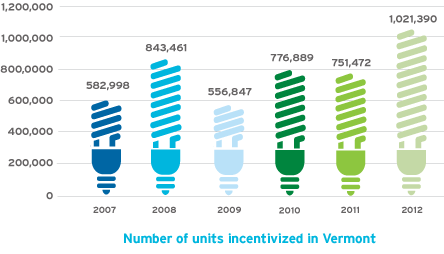The once and future CFL
For most people, compact fluorescent light bulbs (or CFLs) are the face of energy efficiency. This is not surprising, given that the CFL has utterly transformed energy efficiency over the last decade. The rise of the CFL has enabled massive savings forenergy efficiency programs, and has greatly expanded the reach of energy efficiency efforts by serving as a low cost, firstpoint of entry for consumers looking to reduce their electric bills.
If we want to continue realizing savings in theresidential market, the reign of the CFL is by no means over. Although there are a range of residential efficient lighting products that will present further opportunities for savings, the CFL still has great potential because of its relatively low cost and accessibility to consumers. As we transition to other efficient products in the future, it has also provided energy efficiency programs with a valuable framework for understanding how to better engage consumers with their energy use.
Key Insights
- CFL bulbs will continue to be the most widely
accessible and affordable energy efficiency opportunity for homeowners - The potential for home energy savings from lighting is still quite large: In Vermont, energy efficient bulbs
are present in just 33% of light sockets - As the lighting market continues its rapid evolution,oversight and testing by regulatory authorities (such as ENERGY STAR ®) will play a critical role in guiding consumer choices
The Rise of the CFL

The CFL is the iconic symbol of energy efficiency. It stands for the simplicity of the movement: the investment, the innovation, and the reward. But the leap of faith from incandescent to CFL meant abandoning over 100 years of reliance on a single emblem of light and an established home experience. The persistence of the incandescent can largely be attributed to its reliability and ubiquity, and the impact it had on the direction of our human experience. Over the last century, incandescent light bulbs influenced not only our relationship with our homes, but also the design and development of our communities, and the way that we structure our lives.
So why change? Ninety percent of the power consumed by an incandescent is emitted as heat. That means that only 10% of power consumption ends up as light we see. We accepted this fact for over a century. As a new paradigm of limited resources has begun to emerge, humans have recognized the need to be more thoughtful in our energy consumption and develop new technologies such as the CFL.
The CFL had a rocky start. The new technology was sent out into the market by many different manufacturers with little consistency. Characteristics between products were very different as well, especially in comparison with the incandescent bulbs that they were supposed to replace. By the time regulatory agencies and quality testing bodies began their work to ensure the overall quality of CFLs, the public was already having mixed experiences. The result is that even now, when the industry as a whole has learned from its mistakes, it has taken a good deal of effort to regain the trust of consumers. However, CFLs have great potential to save energy and money; a CFL uses one-fifth to one-third of the amount of energy that an incandescent uses and lasts almost five times as long.